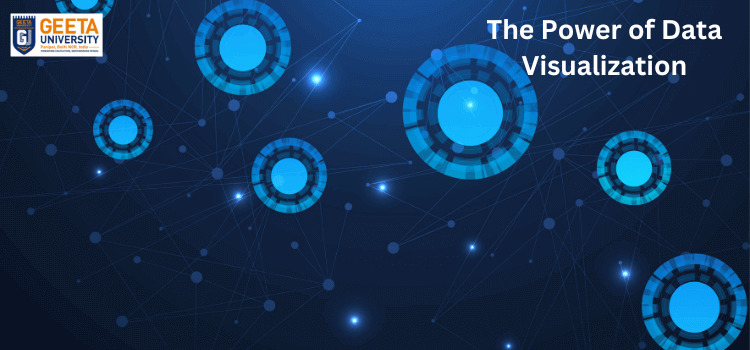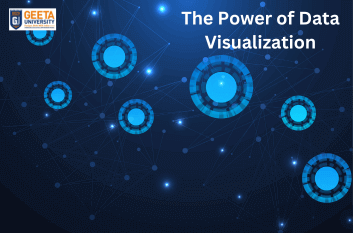The Power of Data Visualization: Turning Information into Insights – Geeta University
Uncategorized Best Career Options in geeta university, best college, best diploma university in haryana, Best engineering College in Haryana, best Law college in Haryana, best mba college in haryana, best MCA college in haryana, Best University for BCA in Haryana, Best University in Haryana, Geeta University, Uncategorized
The Power of Data Visualization: Turning Information into Insights – Geeta University
Welcome to the world of data!!! In today’s data-driven era, we are constantly inundated with vast amounts of information. But how do we make sense of all this data and derive meaningful insights from it? The answer lies in the power of data visualization. It is the use of graphical representations to present complex data in a visually appealing and easy-to-understand format.
In this blog, we will find the importance of data visualization, its benefits, and best practices for creating impactful visualizations.
Why Data Visualization Matters:
Humans are visual beings, and our brains are wired to process visual information quickly and efficiently. Data visualization ,from any top university in India ,leverages this innate ability to process visuals to help us understand complex data and uncover patterns, trends, and insights that might not be apparent in raw data. By presenting data in a visual format, data visualization makes information more accessible, engaging, and actionable.
Benefits of Data Visualization:
It offers numerous benefits for individuals, businesses, and society as a whole. Here are some of the key advantages:
Improved Understanding: Data visualization makes data easier to comprehend by presenting it in a visual format that can be quickly and intuitively understood. Visuals, such as charts, graphs, and maps, allow us to see patterns, trends, and relationships in the data, leading to better understanding and insights.
Enhanced Decision Making: Data visualization enables data-driven decision making by providing visual cues that help identify patterns, outliers, and anomalies in the data. This helps decision-makers make informed and strategic decisions based on data-driven insights.
Effective Communication: It facilitates effective communication of complex information to a wide range of audiences, including stakeholders, clients, and team members. Visualizations make it easier to convey key messages, share insights, and tell compelling stories with data.
Faster Insights: Data visualization accelerates the process of gaining insights from data by presenting it in a visual format that can be quickly analyzed and interpreted. This helps businesses and individuals save time and resources in data analysis and decision-making processes.
Enhanced Data Exploration: Data visualization allows for interactive exploration of data, enabling users to dive deeper into the data, filter, and drill down to uncover hidden insights. This empowers users to ask questions, test hypotheses, and gain a deeper understanding of the data.
Best Practices for Creating Impactful Data Visualizations:
Creating effective data visualizations requires careful planning and consideration of several best practices. Here are some tips for creating impactful data visualizations:
Choose the Right Visualization: Select the appropriate type of visualization that best represents the data and insights you want to convey. Common types of visualizations include bar charts, line charts, pie charts, scatter plots, heat maps, and more. Consider the data characteristics, the story you want to tell, and the audience you are targeting when choosing the right visualization.
Keep it Simple: Avoid cluttering the visualization with unnecessary elements. Keep the design clean, minimal, and easy to understand. Use simple and clear labels, titles, and legends to ensure that the audience can interpret the visualizations without confusion.
Use Appropriate Colors and Fonts: Choose colors that are visually appealing and help convey the intended message. Use contrasting colors to highlight important data points and trends. Similarly, use legible fonts that are easy to read, even in small sizes.
Add Context and Annotations: Provide context to the data visualization by adding relevant labels, titles, and annotations. Explain the data sources, units of measurement, and any other relevant information that helps the audience interpret the visualization correctly. Use annotations to highlight key insights and trends in the data.
Make it Interactive: Interactive visualizations allow users to engage with the data and explore insights on their own.
Conclusion:
Data visualization is a powerful tool that can turn information into insights. By presenting data in a visual format, it helps us understand complex information, make informed decisions, and communicate insights effectively. Following best practices such as choosing the right visualization, keeping it simple, using appropriate colors and fonts, adding context and annotations, and making visualizations interactive can create impactful and engaging data visualizations that empower users to explore data, gain insights, and make data-driven decisions.
So, whether you are a data analyst, a business professional, a researcher, or just someone curious about data, harness the power of data visualization to unlock insights from data and make better-informed decisions.
If you like it , then keep reading the top university in India i.e. Geeta University’s blogs!!!
- By Payal Jaglan
Related Posts
Understanding Nutrigenomics: Can Your DNA Guide Your Diet?
Understanding Nutrigenomics: Can Your DNA Guide Your Diet? Introduction The connection between food and health has been acknowledged for centuries, forming the foundation of many traditional dietary systems and public health recommendations. However, with the rapid progress in genetic science,
Advanced Composites and Hybrid Materials: Pioneering the Future of Engineering
Advanced Composites and Hybrid Materials: Pioneering the Future of Engineering Introduction In the realm of modern engineering, the pursuit of materials that exhibit superior properties has led to the development of advanced composites and hybrid materials. These materials are not
Nano Drug Delivery Systems: Revolutionizing Modern Medicine
Nano Drug Delivery Systems: Revolutionizing Modern Medicine Introduction The field of drug delivery has undergone a remarkable transformation over the past few decades, largely due to advances in nanotechnology. Traditional drug delivery methods often suffer from limitations such as poor



